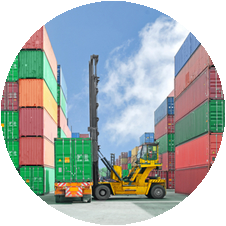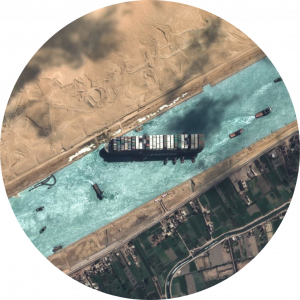 Covid-19 and a global shutdown left the world ready to put 2020 behind us. Little did we know, 2021 would take us for another wild ride. As the pandemic lingered and gained strength in unexpected places, it continued to interrupt supply chains worldwide. Production bottlenecks, volatile swings in pricing, and massive capacity shortages were just a few of the issues that shaped the logistics and supply chain industry landscape in 2021. In this article, we look back at some of 2021’s supply chain issues and highlight some of the industry trends to look for in 2022.
Covid-19 and a global shutdown left the world ready to put 2020 behind us. Little did we know, 2021 would take us for another wild ride. As the pandemic lingered and gained strength in unexpected places, it continued to interrupt supply chains worldwide. Production bottlenecks, volatile swings in pricing, and massive capacity shortages were just a few of the issues that shaped the logistics and supply chain industry landscape in 2021. In this article, we look back at some of 2021’s supply chain issues and highlight some of the industry trends to look for in 2022.
The World Learned The Importance Of Supply Chains
A few years ago, your average person might not have been able to explain what “supply chains” are. Now, it feels like every time you turn on the news, that’s one of the topics you hear. A global shortage of materials caused prices to soar and projects delayed. Ports are congested, labor shortages in trucking have caused delays, a lack of warehouse capacity, and the list goes on. So much disruption happened in 2021 that you may have forgotten about the Suez Canal disaster. For just one year, that’s a lot to process.
 Port Congestion Causing Severe Delays
Port Congestion Causing Severe Delays
As dockworkers contracted Covid-19 or landed in quarantine, loading and unloading at ports are constrained. The pandemic has sidelined truck drivers, limiting the availability of vehicles that can carry products from ports to warehouses to customers. Throughout the pandemic, consumers are purchasing goods rather than services. According to Bloomberg, retail imports set a record high for the United States in 2021. To understand just how clogged the ports were, the average wait at anchor (i.e., the number of days cargo ships waited outside the port) peaked at 20.9 days for the port of Los Angeles. In late December, there were 102 cargo vessels anchored in San Pedro Bay.
A Volatile Pricing Market
International shipping rates hit all-time highs in 2021. Ocean rates increased due to non-stop demand for ocean freight from Asia to the United States and a lack of capacity. Demand and congestion are the main drivers for sustained sky-high rates. To put the situation in perspective, international freight rates in August 2021 reached $10,174/FEU, a 466% increase on the previous year. Experts predict that prices may take two years to return to normal levels based on past market cycles.
Domestic Trucking Shortage
The American Trucking Associations estimated that in 2021 the truck driver shortage would reach over 80,000 drivers. There isn’t a single cause of the driver shortage. Still, a few factors that contribute to the problem are the high average age of current drivers (increased number of retirements), women making up only 7% of all drivers (well below the workforce average), and lifestyle issues such as the time away from home. Although driver pay and earnings have gone up significantly in the past decade, the problem of recruiting new drivers to the industry remains.
 The Suez Canal Blockage
The Suez Canal Blockage
Although it felt like years ago, the Suez Canal debacle happened in 2021. Since its completion in 1869, the Suez Canal has become one of the world’s most essential seaways. This human-made waterway enables a more direct route for shipping between Europe and Asia. According to Reuters, about 12% of the world’s shipping traffic moves through the canal, so the blockage disrupted an estimated $10 billion worth of goods each day.
Natural Disasters Impacting Supply Chains
As if the world needed more supply chain disruptions, 2021 presented challenges out of our control. Hurricane Ida, the Texas winter storm, California wildfires, and significant flooding in Canada are just a few of the events that rattled supply chains across the globe. Hurricane Ida caused destruction and fuel shortages. The winter storm in Texas caused power outages and shipping delays. The California wildfires caused road closures. The floods in Canada caused railway and road damages. The point is, the logistics and supply chain industry had a wild ride in 2021.
Policy Responses
In 2021, the Joe Biden administration introduced proposals to address the ongoing supply chain disruptions. In June, the administration announced a supply-chain “disruptions task force” that created an agreement to operate the Port of Los Angeles 24/7. The task force enlisted freight companies to help move goods off the docks. Furthermore, the Transportation Department provided a $5 billion loan to modernize California ports. Later in the year, the President announced the Bipartisan Infrastructure Investment and Jobs Act. This $550 billion federal investment for America’s roads, bridges, water infrastructure, and more is the largest federal investment in public transit ever.
What To Look For In 2022
There is no indication that supply chain disruptions will ease up in 2022. Bottlenecks, labor shortages, and capacity crunches remain widespread as we begin the year. While nobody can predict precisely when supply chains will normalize, we can predict how shippers will adapt in 2022. Given that supply chains will continue to be stressed, companies must deploy real-time visibility platforms to monitor shipments at the order level. Having end-to-end supply chain visibility and advanced information on lead-time changes can only help navigate these challenging issues.
Understanding that supply chain disruptions are inevitable means that you must plan ahead. 2022 isn’t the year to wait and see if supply chains normalize. By embracing new trends and technologies, companies can minimize these disruptions’ impact on their business.

